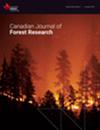Radial distribution of heartwood extractives in second-growth western redcedar
IF 1.7
3区 农林科学
Q2 FORESTRY
引用次数: 0
Abstract
Western redcedar has high economic value and has been traditionally used for cultural purposes by Indigenous communities. Second-growth redcedar is potentially growing faster due to lower planting densities, fertilization and tree breeding. Little quantitative information is available about the impact of management practices on wood quality, particularly heartwood extractives. This study evaluated the effects of growth rate and site on heartwood extractives at two locations aged 70-90 years in British Columbia, Canada. A three-parameter sigmoid model was fit to the data using nonlinear mixed effects to analyze the relationship between heartwood extractives relative to cambial age, growth rate, and sampling site. The southern site had significantly higher cumulative extractive concentrations, while all extractive concentrations increased faster. This study shows that smaller trees will reach their peak concentrations earlier than larger trees. Results show that faster growth through active management of western redcedar may lead to increased and more uniformly distributed content of heartwood extractives.次生西部红豆杉心材萃取物的径向分布
西部红柏具有很高的经济价值,传统上一直被土著社区用于文化目的。由于种植密度较低、施肥和树木繁育,第二代红柏的生长速度可能更快。有关管理方法对木材质量(尤其是心材萃取物)的影响的定量信息很少。本研究评估了加拿大不列颠哥伦比亚省两个树龄在 70-90 年的地点的生长速度和地点对心材萃取物的影响。使用非线性混合效应对数据拟合了一个三参数 sigmoid 模型,以分析心材萃取物与心皮年龄、生长率和采样地点之间的关系。南部采样点的累积萃取物浓度明显更高,而所有萃取物浓度的增长速度都更快。这项研究表明,较小的树木会比较大的树木更早达到峰值浓度。结果表明,通过对西部红柏进行积极的管理来加快其生长速度,可能会导致心材萃取物含量增加且分布更均匀。
本文章由计算机程序翻译,如有差异,请以英文原文为准。
求助全文
约1分钟内获得全文
求助全文
来源期刊
CiteScore
4.20
自引率
9.10%
发文量
109
审稿时长
3 months
期刊介绍:
Published since 1971, the Canadian Journal of Forest Research is a monthly journal that features articles, reviews, notes and concept papers on a broad spectrum of forest sciences, including biometrics, conservation, disturbances, ecology, economics, entomology, genetics, hydrology, management, nutrient cycling, pathology, physiology, remote sensing, silviculture, social sciences, soils, stand dynamics, and wood science, all in relation to the understanding or management of ecosystem services. It also publishes special issues dedicated to a topic of current interest.

 求助内容:
求助内容: 应助结果提醒方式:
应助结果提醒方式:


